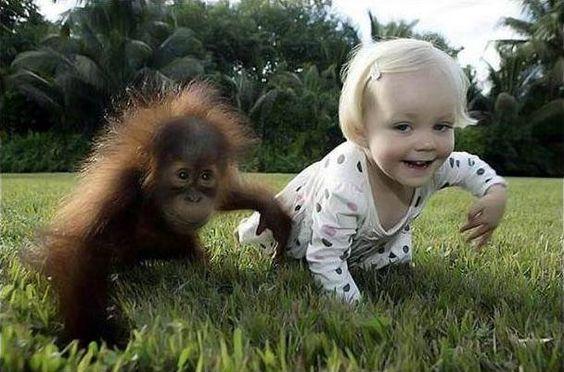This article is directed at religious leaders that hope to engage with mainstream science in a non-combative, creative and productive way. The controversy over science in this article is considered elsewhere, but my real interest is in how I might respond theologically to what I see so clearly in science. Please consider responding to my theological question here.
Recently, several curious religious leaders privately asked me to explain the genetic evidence supporting evolution. They found out about me through my work with the Science for Seminaries Program. After several emails and conversations with these open-minded leaders, I decided to summarize my response here. In particular, be sure to check out the links to Dr. Dennis Venema’s more complete explanations of the evidence for the general public: common ancestry and genetic similarity (parts 1, 2, 3, and 4), synteny (parts 1 and 2), pseudogenes (parts 1 and 2), egg yolk (parts 1, 2, 3, and 4) and hominid evolution ( hominid genetics1 and chromosome 2).
In my opinion, the most compelling and theologically important evidence for evolution is the genetic evidence for the “common descent of man:”2 the scientific hypothesis that humans evolved from a shared ancestor with the great apes (chimpanzees, gorillas, and orangutans). Within the framework of mainstream science, strong evidence for the common descent of man exists, but when taking God into account it is not definitive. This is not a religious statement. It does not presume that evolution is true. And it does not end all our disagreements. And it should not be controversial.
Before summarizing the evidence supporting the common descent of man, I want to start with a story. This story is meant to reduce the fear some feel when encountering evidence that might contradict their understanding of the Bible, and is designed to show that scientific evidence is not definitive. This is the story of the scientist, the theologian, and the 100 year-old tree.

Let us imagine that God creates a fully grown tree today, and places it in a forest. A week later, a scientist and a theologian encounter this tree. The theologian believes that God is trustworthy and has clearly communicated to him that this tree was created just a week ago. The scientist bores a hole in the tree, and counts its rings. There are 100 rings, so he concludes that the tree is 100 years old. Who is right? In some senses, both the scientist and the theologian are right. God created a one week old tree (the true age) that looks 100 years old (the scientific age). Moreover, it would be absurd for the theologian to deny the 100 rings that the scientist uncovered, or to dispute the scientific age of the tree. Likewise, the scientist cannot really presume to disprove God. Instead, the theologian should wonder why God would not leave clear, indisputable evidence that this 100 year-old tree is just a week old.
I tell this story because it might encourage some religious thinkers to fearlessly acknowledge the very strong genetic evidence for human evolution, even if they ultimately disagree with the common descent of man. Currently, it appears that, for some reason, God chose to create humans so that our genomes look as though we do, in fact, have a common ancestor with chimpanzees. If we allow for God’s intervention in our history, it is possible we do not share a common ancestor with apes. Adding God into the picture, anything is possible. Still, even if evolution is wrong, God did created us to appear as if we do have a common ancestor with apes.
What is the evidence for human common ancestry with apes?
The strongest evidence is a series of stunningly discoveries in the details of human and ape genomes. This enables to scientists to perform the equivalent of a DNA sibling test between us and apes, but even more comprehensive.
As makes sense in light of common ancestry, human and chimpanzee genomes are extremely similar (greater than 98% similarity in coding regions), much more similar than we would expect without common descent.3 Remarkably, just as predicted by the fossil record and the rate at which our genomes change, humans are about 10 times more genetically similar to chimpanzees than mice are to rats.

DOI 10.1038/nature04072 , illustrates that humans are about 10 times more similar to chimpanzees than mice are to rats. Horizontal (but not vertical) length plots the genetic differences. By amino acid sequence (Ka), the comparison is 0.245% vs. 2.61% difference. By codon difference (Ka + Ks), the comparison is 1.219% vs. 18.74%. A different or better analysis would adjust these percentages, but not by much. Common ancestry predicts this by recognizing that genomes are better explained by evolutionary history than readily observable differences between species.
In fact, if “microevolution” (a concept many religious leaders affirm)4 can explain the similarity between rats and mice,5 it is reasonable to infer it explains the similarity between humans and chimpanzees. Genetically, humans and apes are the same “kind.” We do not even need to accept “molecules-to-man” “macroevolution” to appreciate the compelling evidence for common ancestry of humans and chimpanzees. Maybe this evolutionary story is false (just like the 100 rings in the tree), and it is certainly incomplete, but it is by far the best scientific explanation of our origins.
This is just the beginning of the evidence in our genomes for common ancestry. In addition to overall similarity, there are several more precise and independent patterns clearly detectable in our genomes, all of which are predicted by the hypothesis of common ancestry but not otherwise expected. In particular, I recommend these carefully explained blog posts about common ancestry and genetic similarity (parts 1, 2, 3, and 4), synteny (parts 1 and 2), egg yolk (parts 1, 2, 3, and 4) , and pseudogenes (parts 1 and 2) at BioLogos. Each of these patterns is an independent test for common ancestry, and by all these tests we clearly look as though we are related to chimpanzees through a common ancestor. This result was predicted by scientists, using the common ancestry hypothesis, and confirmed over the last decade.
Not only do human genomes look like genetically modified chimpanzee genomes, there are also several even more closely related but extinct non-humans, e.g. Neanderthals and Denisovans (see the featured image of the human child with a recreated Neanderthal). For a long time, some religious leaders have hypothesized that Neanderthals are just modern humans with diseases and Denisovans are wishful fictions based only on tiny bone fragments that are likely human. Remarkably, we can now sequence the genetic material in Neanderthal and Denisovan remains, and test if they are just modern humans or not. Confirming the predictions of scientists, these genomes look like sibling species, not modern humans (see hominid genetics, chromosome 2 and mtDNA).
All this evidence, and more, is why scientists say that we share a common ancestor with the great apes. It is as if they bored a hole into the tree, counted the rings, and concluded it was 100 years old. Of course, adding God back into the picture, anything could have happened. An omnipotent God could have created us 6,000 years ago. For some reason, however, He created us to look as if we are uncommonly intelligent apes, more closely related to chimpanzees than mice are to rats, as if we share a common ancestor with them.
So how does the theologian respond to this account?
Denying or ignoring the evidence serves no one. The theologian could look for an overlooked genetic signature that shows that humans were created in a special creative act of God or he could look for errors in the scientific analyses. Still, even if he found standing for quibbles here and there, the overall picture would remain the same and the evidence against common ancestry, at best, would be subtle and debatable. Even if the experts are wrong, they certainly are not ignorant. Human and chimpanzee genomes are very similar, and currently appear consistent with common descent.

Ultimately, even if errors in the scientific account are uncovered, the theologian is left with an important question: why didn’t God make it clear and obvious, in our genomes, that humans did not evolve from apes? It would have been very easy for God to design humans with genomes that were obviously different than apes, and clearly not a product of evolution. From some reason, He did not. He did not even make us as different from chimpanzees as mice are from rats. Why not?
Perhaps, the theologian could consider the great Dietrich Bonhoeffer’s assertion, “A god who let us prove his existence would be an idol.” If God exists, maybe He makes Himself known another way.
Some might be concerned that God made us to look like genetically modified apes, as if we were merely the dust of the earth. Scientifically, this certainly seems true, and it seems senseless for religious leaders denying this evidence. Of course, the scientific account is not the whole story. It is an open theological question how to complete the scientific account, and theological debate surrounding this question is important and engaging. One thing all should agree on; we humans are certainly more than just apes.
References
- http://scienceforseminaries.org
- http://biologos.org/blogs/dennis-venema-letters-to-the-duchess/evolution-basics-genomes-as-ancient-texts-part-1
- http://biologos.org/blogs/dennis-venema-letters-to-the-duchess/evolution-basics-genomes-as-ancient-texts-part-2
- http://biologos.org/blogs/dennis-venema-letters-to-the-duchess/evolution-basics-genomes-as-ancient-texts-part-3
- http://biologos.org/blogs/dennis-venema-letters-to-the-duchess/evolution-basics-genomes-as-ancient-texts-part-4
- http://biologos.org/blogs/dennis-venema-letters-to-the-duchess/signature-in-the-pseudogenes-part-1
- http://biologos.org/blogs/dennis-venema-letters-to-the-duchess/signature-in-the-pseudogenes-part-2
- http://biologos.org/blogs/dennis-venema-letters-to-the-duchess/vitellogenin-and-common-ancestry-does-biologos-have-egg-on-its-face
- http://biologos.org/blogs/dennis-venema-letters-to-the-duchess/vitellogenin-and-common-ancestry-understanding-synteny
- http://biologos.org/blogs/dennis-venema-letters-to-the-duchess/vitellogenin-and-common-ancestry-reading-tomkins
- http://biologos.org/blogs/dennis-venema-letters-to-the-duchess/vitellogenin-and-common-ancestry-tomkins-false-dichotomy
- http://biologos.org/blogs/archive/a-geneticists-journey
- http://biologos.org/blogs/archive/denisovans-humans-and-the-chromosome-2-fusion
- http://www.dnatestingforpaternity.com/sibship-test.html
- http://www.talkorigins.org/faqs/homs/mtDNA.html
- https://www.biblegateway.com/passage/?search=Matthew+12%3A39-42%2CMatthew+16%3A4%2CMark+8%3A12&version=NIV
- http://creationpacifism.org/what-is-creation-pacifism
- https://amazon.com/dp/0842345523/
- http://www.christianitytoday.com/ct/2003/aprilweb-only/4-14-41.0.html
- http://www.reasons.org/articles/bible-and-brains-explain-human-chimp-similarities
- http://swami.wustl.edu/more-than-apes
- http://www.reasons.org
- http://www.evolutionplanet.com/2009/07/deception-in-creationist-orchard.html
- https://answersingenesis.org/natural-selection/speciation/speciation-yes-evolution-no
- https://answersingenesis.org/mammals/rats-no-evolution
Apr 19, 2016
Mar 14, 2021
Dec 24, 2025




